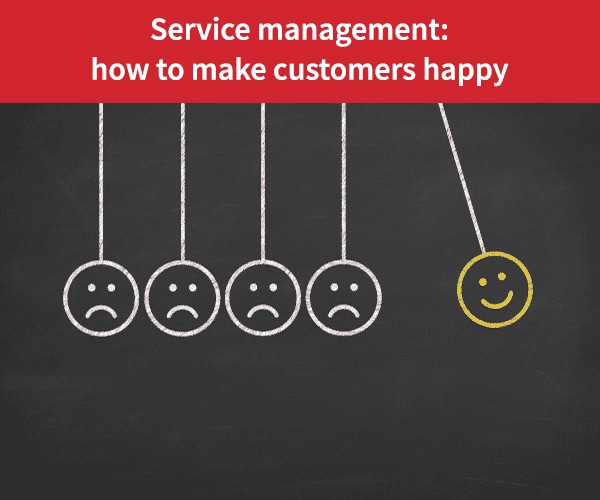
- After-sales service
- Artificial Intelligence
- Customer Satisfaction
- Customer satisfaction
- Work orders
Humanizing customer service in a digital world
In a digital world, making a conscious decision to bring more humans back into customer service roles can give field service providers an important advantage that will help them stand out in the most competitive markets.
Today, technologies such as conversational chatbots and automated FAQ responses have made customer relationship management increasingly digital. While these types of technologies offer undeniable pluses — immediate responses, 24/7 availability — there is also great risk of losing the essence of customer relationships. By definition, a relationship is a connection between things or people — a connection that is profoundly human in nature.
We’ve all experienced the frustration of trying to talk to Interactive Voice Response (IVR) technology that only offers the options of “press 1, 2, or 3” when all we really want is to talk to a flesh and bone human on the other end of the line. Of course, technologies progressed. For example, IVR technology can be replaced with a callbot, a kind of chatbot that’s been customized for telephone conversations and allows people to express themselves freely using natural language.
Mistrust of new smart services is particularly high in business-to-consumer (B2C) markets. According to a recent Accenture Strategy study in France, less than one-third of French consumers (29%) believe that customer experience is improved when companies learn about their needs and personal preferences.
While the majority (83%) of consumers who already use digital assistants appreciate the experience, 40% find it disturbing when the technology starts to correctly interpret and anticipate their needs. And 47% of respondents fear that new smart services will learn too much about them and their families.
B2B companies can learn from B2C practices
In the business-to-business (B2B) world, expectations are different. Naturally, confidentiality is also a major concern and data protection regulations mandate that businesses act in a transparent way to establish trust.
However, it’s the quest for efficiency that dominates in the business world. Customers who want to submit a service request expect they will be able to do so quickly and easily no matter what media they’re using. If call centers have unreasonable wait times or customers are stuck listening to soulless IVR systems, they’ll switch to one-way communication channels such as email so they’ll receive an answer within the hour.
Requirements are on-the-rise
Quality of service requirements have also increased. This is where B2B companies can draw inspiration from the practices and strategies used in the B2C world. Today, people expect the interfaces they use in their professional lives to be as intuitive and ergonomic as those they enjoy in their private lives.
The goal is to eliminate all of the annoying factors that so often make the B2B customer journey a long and complex one with many hoops to jump through, many stages to complete and many people to talk to. It’s also wise to send customers an online request for feedback at the end of the process to gain insight into the customer service improvements they’d like to see.
An omnichannel strategy is key
Finally, business people expect to be spoiled for choice with the ability to use their preferred communication channel— phone, text message, email, instant message, chatbot, extranet, customer portal — to request service and stay informed about the progress of their request. They also expect the ability to switch between mobile and fixed devices at any time.
These requirements mean field service providers must adopt an omnichannel communication strategy. Field service management software centralizes the data from all of these different communication channels to provide a unified view of each customer to everyone in the information chain, from schedulers to accountants and, of course, on-site technicians.
While this approach can be seen as a paradox, technology can be used to enrich human relationships. Think of field technicians as brand ambassadors. When they’re aware the customer has expressed dissatisfaction through different complaints, they can behave differently with customers when they’re on-site.
Combine the best of human and digital worlds
The optimal approach is to combine the best of the human and digital worlds. When customers experience a basic problem, they may prefer to resolve the issue themselves and have no need to talk to a human.
In these cases, field service providers can offer a selfcare web page that follows responsive web design principles to provide first-level support through FAQs, technical documentation and user support forms. If customers can’t find the information they’re looking for, they can interact with chatbots that are connected to a knowledge base and can automatically provide them with technical data sheets and tutorials as needed.
Websites must also enable human interactions. For example, a live chat module allows customers to speak with a person rather than a robot. And a call-back button on the web page ensures someone phones the customer as soon as possible.
Conversations must flow between humans and machines
The challenge is to offer a seamless customer journey where people can switch between human interactions and digital interactions. When a chatbot reaches the limit of its knowledge, it must quickly handover the conversation to a human. The person who takes the handoff can see a complete history of the exchanges so they don’t have to start the conversation from scratch.
Stubborn chatbots are counterproductive. It’s estimated that people give up after two or three responses miss the mark. According to users polled in a Pegasystems study, 27% of virtual agents don’t answer questions effectively. Respondents also noted the dehumanizing nature of the exchanges.
Artificial intelligence plays a key role
To avoid this feeling of frustration, a chatbot must focus on recurring and basic requests such as how to create a service request. When these types of low value-added tasks are offloaded from humans, they can focus on the essentials, such as listening to the customer. This is how technology can help to rehumanize customer relationships.
The future should be about the marriage of humans and technology. After it launched Duplex, artificial intelligence (AI)-based technology that makes reservations on behalf of people, Google launched CallJoy.
With CallJoy, AI technology helps small and medium-sized businesses by fulfilling basic phone requests for schedules and appointments. It also filters out spam calls and sends text messages. If the caller needs to speak with someone in the company, the AI technology immediately hands the call over to a human.
Our similar articles.
-
- Field Service Management
- Optimization
- After-sales service
- Work orders
- Technology
Impact of new technologies on the future of field service management
March 20, 2018 -
- Field Service Management
- Customer Satisfaction
- Optimization
- Work orders
How service companies can make customers happy
November 1, 2018 -
- Field Service Management
- Customer Satisfaction
- Optimization
- Work orders
Field service management: 5 practices to avoid in order to boost your business
April 7, 2023


